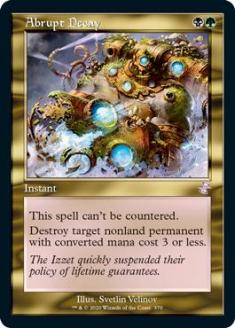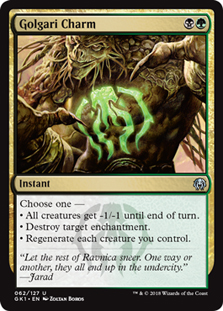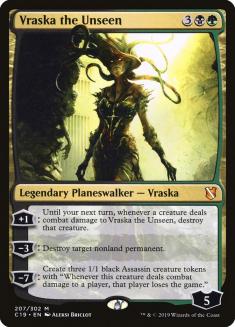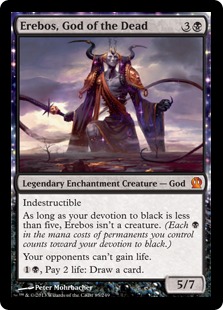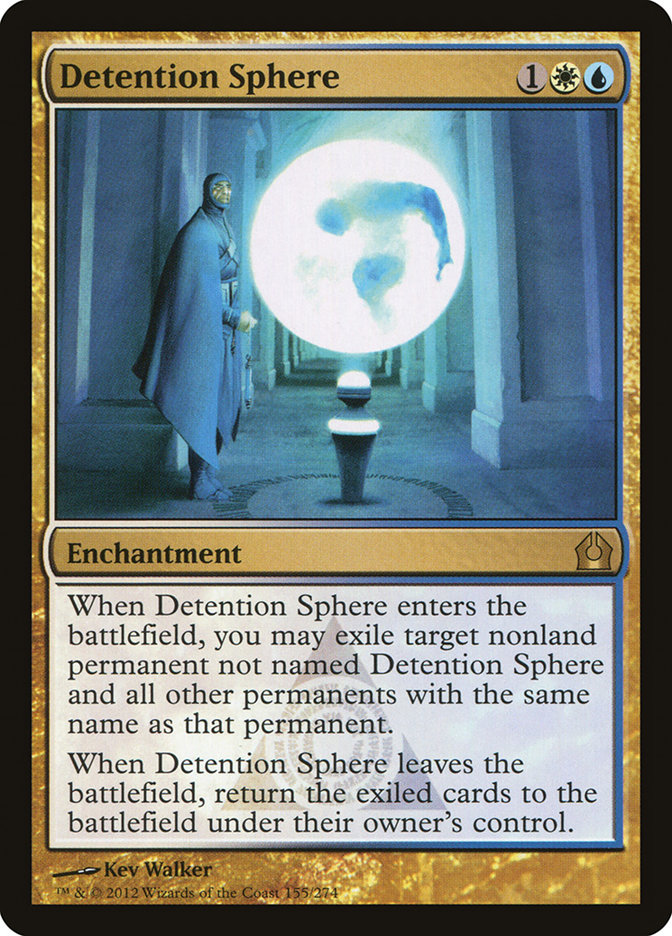I’ve been experiencing something of a conundrum.
If I’m going to boil it down, perhaps the simplest way to boil it down is to show you all two of the decklists that I noticed from Star City Games Spring
State Championships, Brandon Nelson’s winning U/W Control list from North Dakota and Josh Ravitz’s winning B/G Devotion list from Washington:
Planeswalkers (7)
Lands (27)
Spells (26)
- 1 Syncopate
- 1 Negate
- 1 Elixir of Immortality
- 4 Azorius Charm
- 4 Supreme Verdict
- 4 Detention Sphere
- 4 Sphinx's Revelation
- 2 Celestial Flare
- 4 Dissolve
- 1 Banishing Light
Sideboard

Creatures (16)
Lands (25)
Spells (19)

Brandon Nelson’s list is, for all practical purposes, Eric Rill’s list from SCG Cincinnati. The only real changes are
swapping the off-color Temples for different off-color Temples that produce the same on-color mana. This is, in essence, a “75-card” replica.
While not everyone will go for Rill’s approach (I still hear a great deal of debate on whether or not Elixir of Immortality is correct or not in the
current metagame), the fact remains that the particulars of this build continue to be successful.
Joshua Ravitz’s list, to me, continues down the path that Andrew Tenjum lit up. Tenjum’s deck actually beat Rill’s deck in the finals of SCG
Cincinnati, and Ravitz’s version looks like a slightly more conservative, streamlined build of Tenjum’s deck. I definitely appreciate Ravitz’s removal of
one of the Guildgates, especially in a deck that no longer is trying to support Nightveil Specter. Carving space for Bile Blight (removing a Hero’s
Downfall and Vraska the Unseen) also makes sense to me, although I’d probably prefer to keep the Vraska, though Ravitz does make room for it in his board.
Between Ravitz’s version and Tenjum’s, there are good models for people to use to make use of Abrupt Decay and Pack Rat in the same deck.
While I can’t speak to the quality of the opponents at either Brandon’s event or Josh’s event, I can speak to the quality of these two competitors as
players. Neither of them is someone I would be excited to be paired against. They both have a great deal of experience playing in high-pressure
tournaments, and particularly in the case of Brandon, he’s playing a deck firmly in his own wheelhouse.
These decks neatly capture the struggle I’m having.
Ultimately, I want to be casting Sphinx’s Revelation right now. It’s an incredibly powerful spell, and it feels like so many decks just crumple or wilt
once you cast it. Provided the rest of your deck is doing something to interact with your opponent, most games just feel like they are a ‘lights out.’
Previous to Journey into Nyx, playing against Black Devotion felt great. I spoke with Eric Rill about the ‘script’ of the game, and he and I both agreed
that unless Black gets out early, they just fall to the late-game Revelations, even if they are drawing cards. In sideboarded games, they are better
equipped to fight the fight, but they don’t really get back into the fight once they are down. At least not usually.
Here was a match I had that depressed me about the deck:
Me: Untap with 9 mana up, Sphinx’s Revelation in hand, and countermagic at ready into a board state with no threats in play. Say “Go”.
Him: End-of-turn, activate Underworld Connections. Untap, Underworld Connections again. Abrupt Decay Detention Sphere on Vraska the Unseen. Use Vraska on
Detention Sphere on Erebos, God of the Dead.
I responded by drawing six cards, but I never came back.
Maybe I should have held up countermagic, but the six life felt important.
When I’m slinging Sphinx’s Revelations, I get a little sick when I think about this set of cards:
Nearly half of the spells in the Black Devotion deck are truly hateful cards when the deck gets to splash green. This isn’t even counting the workhorse
cards like Underworld Connections, Lifebane Zombie, Pack Rat, and more. The new cards aren’t many in number, but they are intense in their power:
It used to be that Pack Rat and friends would bring in ten cards. Now they have over 50% more cards, and those cards are actually fundamentally
different in how they affect games. Abrupt Decay wouldn’t be so horrible if you could actually, you know, counter it. Golgari Charm actually has
three valuable modes against U/W Control, not the least of which is providing a pseudo-counterspell to your Supreme Verdict. Vraska, normally a card that
I’m not actually excited about, is quite intensely good when it not only wipes out any of your Oblivion Rings, but it also demands that you answer it before you can answer Underworld Connections.
It just doesn’t seem like an exciting time to be playing this card:
Even other decks felt like they were getting in on the act. Whether it was their Banishing Light, Deicide, Abrupt Decay, or something else, there seemed
like there was an endless assault on Detention Sphere, and even though I was still winning games, there were plenty of games that just got away from me,
even though it didn’t feel like they should have. Perhaps I was living in the past.
And so, at a few events I played this deck:
Creatures (24)
- 1 Scavenging Ooze
- 2 Aurelia, the Warleader
- 4 Ghor-Clan Rampager
- 4 Boros Reckoner
- 4 Voice of Resurgence
- 4 Stormbreath Dragon
- 3 Fleecemane Lion
- 1 Xenagos, God of Revels
- 1 Brimaz, King of Oreskos
Lands (25)
Spells (11)

I’m still trying to figure out the changes that I need for this deck (4 Fleecemane Lion is the only one I’m certain of), and it certainly felt incredibly
powerful. But, especially at the Super Sunday event at Grand Prix Minneapolis, I kept seeing other players near or ahead of me in the standing doing well
with U/W Control.
I particularly remember watching one mirror match and wishing I could be either one of them. One of them had beaten me and my Naya deck earlier, as I’d sat
on triple Stormbreath Dragon waiting for a fifth mana, only finding it way too late. While I sat, turn after turn, hoping for that mana, he cycled his
Azorius Charms until he got to a Sphinx’s Revelation for three and then dropped an Elspeth, Sun’s Champion. I still almost won the game, but I couldn’t
quite make it happen. Both when I played against U/W Control and when I watched it, I really struggled to come up with a reason not to be playing U/W.
Online, of course, I’d get Decayed and Golgari Charmed and Vraskaed (Verbing weirds language!) It was clear that B/G was gaining traction, and yet, I
wasn’t sure how much it had done. What to do?
If Tenjum and Rill’s SCG Cincinnati decks have continued to have legs a month later, to me, it stands to reason that other decks that did well would also
experience the same general success. Take Mike Abner, for example, who finished 9th at SCG Cincinnati, tied for Top 8 with his update to my U/W
Control deck. His only loss in the event? Me. (Sorry, Mike.)
Here was his version of the deck:
Creatures (1)
Planeswalkers (5)
Lands (26)
Spells (28)
- 1 Last Breath
- 1 Syncopate
- 2 Divination
- 1 Essence Scatter
- 1 Elixir of Immortality
- 2 Azorius Charm
- 4 Supreme Verdict
- 1 Cyclonic Rift
- 4 Detention Sphere
- 4 Sphinx's Revelation
- 1 Azorius Keyrune
- 1 Celestial Flare
- 4 Dissolve
- 1 Fated Retribution
Sideboard

When I say “My U/W deck”, I’m referring to some of the pretty clear markers (rational emphasis on Singletons, as well
as specific card choices like Azorius Keyrune, Cyclonic Rift, Divination, and Debtor’s Pulpit, to name a few). One of the things that I’ve loved about the
deck is that I feel like when I’m playing against other control decks, they just don’t have the same firepower that they’re bringing to the fight. All of
the little details end up mattering. While I wouldn’t have my deck built in the exact same configuration that Mike chose when he updated the deck, it would
be fairly similar.
So, here was the question I began to ask myself:
Can you build a successful Sphinx’s Revelation deck without Detention Sphere?
(And, yes, I’m counting Banishing Light as ‘Detention Sphere.’)
Perhaps you can simply just “get away with it” with Black, when you have access to Hero’s Downfall to just take out a Planeswalker. The only list I could
find that was remotely close to what I was looking for was this list:
Creatures (3)
Planeswalkers (6)
Lands (26)
Spells (25)
- 2 Thoughtseize
- 2 Divination
- 4 Azorius Charm
- 4 Supreme Verdict
- 1 Detention Sphere
- 3 Sphinx's Revelation
- 3 Ultimate Price
- 3 Hero's Downfall
- 3 Dissolve
Sideboard

Unfortunately, this was a pretty small event (no disrespect intended to Mr. Townsend). Still, it is a point of evidence that perhaps you can maybe
successfully do it. The other point of evidence came from Evan Erwin, who helpfully pointed out this deck to me:
Creatures (1)
Planeswalkers (6)
Lands (31)
Spells (22)
- 2 Syncopate
- 2 Thoughtseize
- 2 Divination
- 4 Azorius Charm
- 4 Supreme Verdict
- 4 Sphinx's Revelation
- 4 Dissolve
Sideboard

Ryan Dietz’s Top 8 finish at an SCG SuperIQ comes without a single Detention Sphere, and access to black. Amazingly, though, he also didn’t choose
to use Hero’s Downfall! Still, I find myself wondering if perhaps there is an error on the decklist… He has 31 lands listed, and “4 Detention Sphere”
might make more sense than four of those lands.
Whatever the case may be, a month later he was playing five Detention Sphere effects with this deck (so whether he engaged in an anti-Sphere
experiment or not, he abandoned ship on the idea):
Creatures (1)
Planeswalkers (5)
Lands (26)
Spells (28)

Even without much in the way of evidence, I decided to take the plunge, and make a deck that would have absolutely no targets for Abrupt Decay, to see if
it could be reasonable. I had a list that I really loved, but, unfortunately for me, the only place I could really play it is on Magic Online, and I’ve
been having a horrible time with lag. This isn’t connection-based lag, either; this is something wrong with how my client performs (and has
performed, on every computer I’ve had for a while).
In one example, a bit more than a year and a half ago, Jackie Lee was watching me play my 4-Color-Control deck (which she would take to a Top 8 at a $5k
event) and she said, “That was a mistake.”
“What was?”
“Putting that land into play. You’re going to lag even more now.”
And she was right.
For whatever reason, when I put more permanents into play, Magic Online starts slowing down. This, unfortunately, isn’t a great turn of affairs when you’re
playing a Sphinx’s Revelation deck, and you need to be dropping at least one permanent into play every turn, and when activating Elspeth, Sun’s
Champion could mean timing out during your attacks.
During this time, I rage-quit a few times, incensed. In one instance, the rage was deep:
Opponent casts Thoughtseize – I have 15:27 left on the clock and attempt to do nothing other
than Warleader's Helix in Response. 14:39 left.
— Adrian Sullivan (@AdrianLSullivan) May 25, 2014
Eventually, I got in enough games to feel pretty good about where I was at in exploring the world of a Detention Sphere-free deck. I’m certainly still
experimenting, but the initial results look really exciting.
Creatures (2)
Planeswalkers (5)
Lands (27)
Spells (26)

While I’m still not certain whether or not it is more reasonable just to play it conservatively, and, in the face of the potential rising wave of B/G
Devotion and Abrupt Decay, just go with Detention Sphere, this deck is a testament to the fact that you don’t necessarily need Detention Sphere.
There are certainly times when you feel the absence of the card. I was quite pained to discover just how much better Planeswalkers were against the deck,
even with some of the resistance the deck naturally provides (more counters in Izzet Charm, actual burn spells, 3 Mutavault).
While I won’t discuss every card choice, I thought I would talk a little bit about a few of the cards:
Azorius Charm
– I have been struggling with Azorius Charm for a long time. At times, I’ve had four copies of the card in my U/W Control lists, and I’ve always gone to it
as my default card to cut. Eric Rill, on the other hand, basically considered it the perfect card for the deck, functioning as removal or cycling, and
doing a fine job at both. I think that because it doesn’t do an exemplary job, I’ve wanted to cut it lower, but Rill’s thoughts certainly echoed in my
head, and I went back up to three, especially since I won’t have the removal that a Detention Sphere provides.
Izzet Charm
– This card actually surprised me when I played it. It was so good that I thought, “I need more of this!” One of the things that Sphinx’s Revelations decks
can accomplish is providing almost an excess of cards. One of the reasons that I had previously run extra copies of ‘throw away’ cards like
Cyclonic Rift and Disperse was that you make up that card loss later. For Izzet Charm, the counter and burn modes are very useful, but when you have a deck
that often has an excess of cards, the ‘Looting’ mode is actually great as well.
Deicide
– I think we’ve just rounded that bend where maindeck enchantment removal is worthwhile.
Turn//Burn
& Warleader’s Helix – As I evolved the deck, I knew that I wanted to have access to true burn spells. Without a card like Detention Sphere, I
wanted to be able to answer a Jace, Architect of Thought when it ticked down to two. In addition, I wanted to be able to potentially answer a creature.
Turn//Burn is even able to answer a God! (Well, if it is embodied.) I might end up going to three Warleader’s Helix, but for now, here I am.
Render Silent
– I was boarding Render Silent in against everything. In addition, unlike some “board it in against everything” cards, I wasn’t boarding it in to adapt to
their game 2 strategy, I was just boarding it in because it was useful. This is the key to determining a card as a game one card. I only wanted so many
actual counterspells, so this bumped out a Dissolve. I would play more, but UUW actually is prohibitive on the mana. One it is.
Darksteel Ingot
– This isn’t an Azorius Keyrune. That being said, as the 28th (!!) mana in the deck, it does accomplish the ramping that I really like the deck to have
access to. In addition, it makes the various colors in the deck work well, and between Izzet Charm and Trading Post, feels like it has extra utility.
Keranos, God of Storms
– Initially, I thought this card was much, much better than it is. That said, basically if you untap with this card in play, the advantage it
gives you is relentless and horribly difficult for another deck to overcome. You just need to survive that turn you cast it, and then it functions like a
kind of Planeswalker that can’t be attacked.
Sideboard Counterflux
– If you have access to blue and red and you are playing counterspells, it can be hard not justifying some number of this card, particularly if you are an
Elixir of Immortality deck, and can bring them back into the mix.
Sideboard Trading Post
– Burn is real. Perhaps this should be a Nyx-Fleece Ram or an Archangel of Thune. Right now I’m trying Trading Post, but I’m open-minded to other cards.
After a long set of sessions with this deck, I remain torn between playing the U/W Control deck that I’ve been working on since the beginning of the year,
switching to a Detention Sphere-free version like the one I’m spotlighting in this article, or abandoning ship completely and returning to the attack
phase. To me, the real answer to this question involves paying careful attention to B/G Devotion as well as decks that are heavy in Planeswalkers, the
place where you’ll most miss your Detention Spheres. If there are suddenly a ton of Bant Planeswalkers decks, the most conservative style of U/W is
probably the way to go; if Abrupt Decay is ruining everyone’s day, perhaps you’ll join me in experiment with other ways to play Sphinx’s Revelation,
whether it is something like my U/W/r Control deck, or another path.
Or, hell, maybe you’ll just throw up your hands, and find some creatures with power and toughness, and go from there. I hear Boros Charm and Dryad Militant
are cards.
There are still a few weeks until the Invitational, and I intend to figure out which path is for me.

